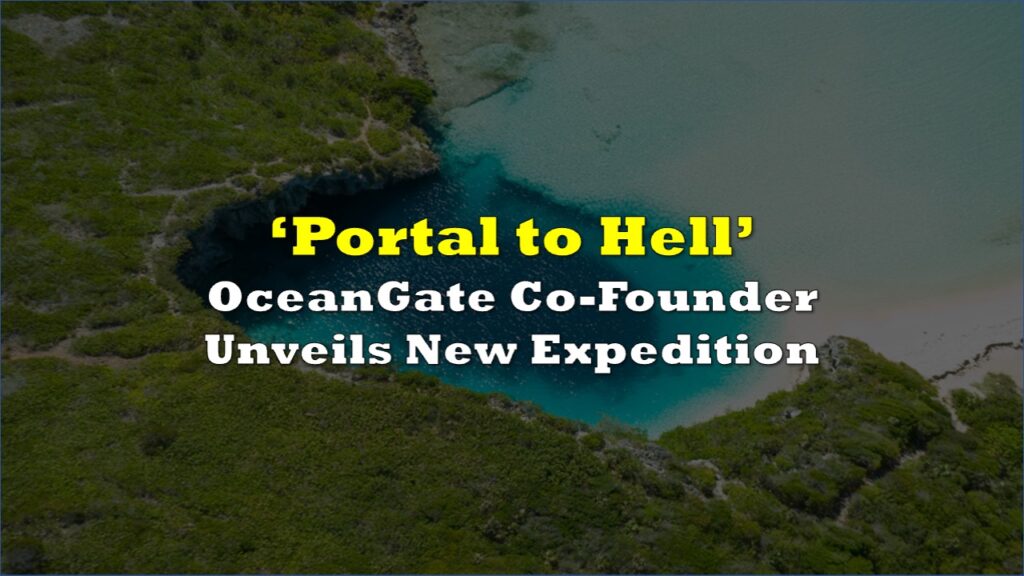In the murky depths of the Atlantic, a modern-day troupe of explorers embarked on a quest to visit the damsel in distress, the Titanic.
Leading the aquatic chariot, dubbed “Titan,” the dauntless founder of OceanGate Expeditions, Stockton Rush. With him, Paul Henry Nargeolet, an ex-Navy man with saltwater in his veins, Shahzada Wood, a Pakistani billionaire, along with his 19 year old son, and Hamish Harding, another billionaire whose son is currently attending a Blink 182 concert while tweeting for sympathy.
On a mission to visit the Titanic, whose tragic maiden voyage once captivated the world, the submersible Titan descended 13,000 feet, where the pressure is a whopping 378 times that at the surface.
The Titan’s very walls, cocooning its occupants in a space cozier than a minivan, consisted of five-inch-thick carbon fiber, capped by a dome of titanium strong enough to repel a Kraken.
Now, this isn’t OceanGate’s first underwater rodeo. They’ve been bringing in the big fish — correction, the wealthy fish — since 2021. And at a ticket price of $250,000, it’s a ride that laughs in the face of Disneyland’s It’s a Small World, but a token amount of money for a billionaire to do something very few people in the world ever get to do.
But herein lies the twist — after a mere 1 hour and 45 minutes, the Titan went silent as a ghost ship. We wonder if it’s pining for an extended stay with the Titanic, or got embroiled in a Jules Verne-esque adventure? Equipped with 96 hours of emergency oxygen, and allegedly piloted by what looks like a $30 Logi-Tech gaming remote the submersible is missing in action.
In the prequel to this tale, red flags billowed like pirate sails. Experts since 2018 waved cautionary tales of OceanGate’s “experimental” approach to their expeditions.
And of course, and there’s Mr. Lochridge, OceanGate’s former director of marine operations, who was the bearer of unwelcome truths, and who made pleas for inspection and certification of Titan that went unheeded.
Today were going to diving into the story of the missing Titan submersible.
David Lochridge identified numerous issues that posed serious safety concerns with the sub and offered corrective action/suggestions. He was particularly concerned about lack of testing/scanning on the hull to uncover defects, but was told the technology to do scans didn't exist pic.twitter.com/owPeoQ51JI
— Kim Zetter (@KimZetter) June 20, 2023
What we know about the Titan
Let’s start off with what we know about the submersible and the current situation.
The Titan submersible’s expedition to the Titanic wreck site is operated by OceanGate Expeditions and costs upwards of $250,000 per participant. The expedition commenced as part of an eight-day journey, which began on a Sunday and involved traveling 400 nautical miles to the wreck site from Newfoundland.
The exact number of trips that the Titan has conducted to the Titanic in the past is not mentioned in the provided information, but it has been in operation at least since the previous year, as evidenced by a trip documented by CBS correspondent David Pogue in the prior year.
This submersible does not have any kind of beacon like that. On my expedition last summer, they did indeed get lost for about 5 hours, and adding such a beacon was discussed…
— David Pogue (@Pogue) June 19, 2023
Here is a clip of CBS reporter David Pogue giving us a glimpse of just what this submersible experience is all about.
Y’all please watch this. It’s a CBS story that aired a while back about that submarine that is now missing. The creators of that missing submarine are DEEPLY unserious. pic.twitter.com/B6JriITyZj
— Marie, MSN, APRN, FNP-C (@FnpMarieOH) June 19, 2023
Regarding the depth, the Titanic wreck rests at a staggering depth of nearly 13,000 feet below sea level, and the Titan submersible was designed to descend to such depths.
The submersible was reported to have approximately 70 to 96 hours worth of oxygen, depending on the circumstances. US Coast Guard officials estimated that, as of Tuesday afternoon, following the day the Titan went missing, there was about 40 hours of oxygen remaining in the submersible – suggesting that search and rescue had until Thursday evening to locate and open the vessel.
Who is on the ship?
Onboard the Titan submersible that went missing were five individuals; four mission tourists and one pilot. Among the mission tourists were Shahzada Dawood and his son Suleman Dawood, both originally from Pakistan but residing in Surrey, UK. Shahzada, a Vice-Chairman at the Pakistani polymer and chemical company, Engro Corporation, belongs to one of Pakistan’s wealthiest families.
Another passenger is Hamish Harding, a 58-year-old British national, who is a businessman, pilot, and explorer. He holds three Guinness World Records, including one for the longest time spent in the deepest part of the ocean on a single dive. He was also part of a Blue Origin flight to space in 2022.
🚨 Who are the five passengers aboard the missing Titanic sub?
— Insider Paper (@TheInsiderPaper) June 20, 2023
1. OceanGate CEO Stockton Rush
2. British businessman Hamish Harding
3. Retired French navy commander Paul-Henri Nargeolet
4. Pakistani businessman Shahzada Dawood an
5. Shahzada Dawood's teen son, Suleman.
And then we have Paul-Henri Nargeolet, a renowned expert on the Titanic wreckage. The 77-year-old former French Navy officer, has been involved in Titanic research since 1987, and is often referred to as “Mr. Titanic”. He supervised the recovery of over 5,000 objects from the Titanic site and authored a book titled “The Depths of the Titanic” in 2002.
And of course, the fifth individual on board is Stockton Rush, the CEO of OceanGate Expeditions, which operates the Titan submersible. Stockton, a former United Airlines captain, founded OceanGate in 2009 with the vision of making it the world’s leading provider of crewed submersibles for charter and research.
What could have happened?
We’re not even going to pretend to be experts on submersibles, but based on a few of the articles we’ve read here are some of the possible scenarios for what may have happened.
- Got stuck on the Titanic: With the Titanic’s wreck being situated at a depth of approximately 3,800 meters, the submersible may have navigated too close to the wreckage and become entangled or wedged in some part of the ship. Given that the Titan was operating independently without a tether, maneuvering too close to the Titanic’s deteriorating structure could have made it susceptible to getting trapped.
- Catastrophic leak: Given that the pressure at the depths where the Titanic rests is roughly 380 times greater than atmospheric pressure at sea level, the Titan’s hull would have been under immense strain. Despite being made of materials such as carbon fiber and composite titanium that are designed to withstand such pressures, a defect or failure in the hull’s integrity could have led to a catastrophic leak or even an implosion.
- Incapacitated and drifting in deep sea currents: If the Titan suffered a power failure or a system malfunction, it could have become incapacitated and carried away by deep sea currents. Considering that the submersible has a real-time hull health monitoring system, it’s possible that an unforeseen mechanical issue occurred, rendering it motionless. In such a scenario, without the ability to navigate, it could be at the mercy of the currents.
- Made it to surface but lost communication with Starlink: It’s possible that the submersible made it back to the surface but lost communication with the support vessel. The article mentions that the Titan had an acoustic link for communication, which might have failed. Additionally, if it surfaced in adverse weather conditions, it could further hinder the ability to establish communication. With the passengers potentially stuck inside (as the submersible might be bolted from the outside for pressure integrity), they could be awaiting rescue without a means to communicate their location.
What’s the current situation?
So next let’s get into the rescue missing?
Canadian and U.S. authorities are conducting an extensive search in a vast area of the North Atlantic, which exceeds 10,000 square miles. To put this into perspective, this search area is larger than the state of Connecticut.
#Update A Canadian Aircraft P3 Aurora has arrived on scene to conduct sonar searches.
— USCGNortheast (@USCGNortheast) June 20, 2023
The R/V Polar Prince and R/V Deep Energy are continuing their surface searches.
Total search area completed as of this morning is 10,000 SQ miles.#Titanic
The Canadian military has deployed sonar buoys into the search zone to listen for any acoustic signals that may emanate from the Titan.
In addition, a French research vessel with a deep-sea diving robot onboard has been dispatched to join the search efforts upon the request of the U.S. Navy. This vessel is expected to significantly aid the operation given its specialized equipment, crucial for searching in deep-sea conditions.
And most recently a glimmer of hope, with around 25 hours of oxygen left, loud banging noises were detected in 30 minute intervals, according to internal e-mail updates sent by the Department of Homeland Security’s National Operations Center obtained by Rolling Stone.
But still experts, are saying it’s still like finding a needle in a haystack.
19/n
— TheIntelFrog (@TheIntelFrog) June 21, 2023
REPORT: Internal DHS documents state a Canadian P-8 heard "banging" every 30 minutes for 4 hours near the last known location of TITAN. https://t.co/WcuHk94VyQ
Wrapping it up
The fate of these modern-day explorers, encased in a submersible, is eerily reminiscent of the very ship they sought to visit – the Titanic. Like the Titanic, they dared to challenge the limits, surrounded by both the wonder and the peril of the ocean’s depths.
The world watches with bated breath as the rescue teams scour the immense expanse of the Atlantic, but the vastness and depth of the ocean are formidable adversaries in this race against time. The dedicated rescue efforts, utilizing cutting-edge technology, reflect the indomitable human spirit to protect life.
Yet, questions abound about the planning and safety measures taken by OceanGate Expeditions.
The Titan’s disappearance serves as a reminder of the relentless and unpredictable nature of the sea, and of the price of human daring. Irrespective of the outcome, this incident will undoubtedly become a part of the maritime annals and perhaps serve as a catalyst for renewed scrutiny and regulations in deep-sea exploration.
Information for this briefing was found via Reuters, CNBC, Bloomberg, and the sources mentioned. The author has no securities or affiliations related to this organization. Not a recommendation to buy or sell. Always do additional research and consult a professional before purchasing a security. The author holds no licenses.











